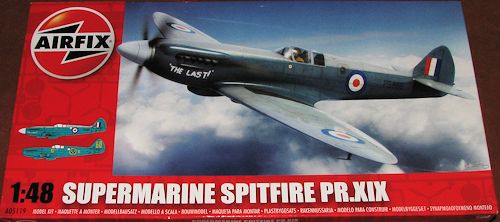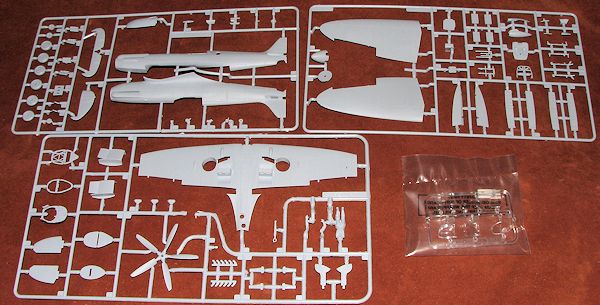
Airfix 1/48 Spitfire PR.19
| KIT #: | A05119 |
| PRICE: | $22.99 SRP |
| DECALS: | Two options |
| REVIEWER: | Scott Van Aken |
| NOTES: |

| HISTORY |
The Spitfire was not only an excellent short range fighter, but it was also one of the best photo recce aircraft that the RAF operated. This was especially true for tactical reconnaissance where speed was of major importance. Get the pictures and get back! The final version of the aircraft developed for reconnaissance duties was by general consent the best, the Spitfire PR19. This version saw extensive service after the war in a number of theatres. This version built on all the lessons learnt from previous aircraft, combining the wing of the PR 11 containing 66-gallon leading edge fuel tanks and potential camera installation and was powered by the 2000hp Griffon 65 series engine used in the Mk14. The total internal fuel capacity of the PR19 was 252 gallons, although there was the option of also carrying a 90 gal or 170 gal drop tank, the added drag virtually outweighed the benefit and it was rarely carried.
The camera installation was fairly similar to that used for the Mk 11. Within the fuselage were mounted various cameras, either two fanned or a single F52 36in vertical, two fanned F52 20in vertical or two fanned F24 14in vertical and one F24 14in or 8in oblique. The fuselage cameras were heated by warm air ducted from behind the starboard radiator. Additional cameras could also be carried in the wings in place of the inter-spar fuel tanks and these were also heated by warm ducted air. The installation of a full pressure cabin made life much more comfortable for the pilot during freezing high altitude, long endurance reconnaissance sorties that the type was occasionally tasked with performing. The last operational flight made by any RAF Spitfire was flown by a PR 19 over Malaya on 1 Apr 1954. That happens to be the box art plane and one of the markings options in this kit.
| THE KIT |
 Nice to see
this one being released. Airfix is apparently on a roll to do as many Spitfire
variants as is economically viable. Their previous Griffon Spits have done well
and have filled gaps that have been previously only handled by aftermarket. To
many, the PR.19, unencumbered by gun bulges or rocket rails or bomb racks, is
one of the sleekest looking of the Spitfire family.
Nice to see
this one being released. Airfix is apparently on a roll to do as many Spitfire
variants as is economically viable. Their previous Griffon Spits have done well
and have filled gaps that have been previously only handled by aftermarket. To
many, the PR.19, unencumbered by gun bulges or rocket rails or bomb racks, is
one of the sleekest looking of the Spitfire family.
Airfix spends quite a bit of the build in the cockpit. This includes a well done instrument panel, all the framework you'd normally see when looking into the cockpit, a nicely done seat, what I assume to be O2 bottles behind the seat, a lot of sidewall detail and various bits and pieces that fit onto the sidewall. The seat comes with an add-on armor plate, but I'm not sure if this would have been fitted to the two markings options or not. Your choice. There is also a complete camera bay behind the seat so no need to go aftermarket on this (as I did with the 1/72 version). Since there is no belt detail given, a pilot figure is included to mask that and hide any other work you have done in the cockpit!
One thing about all that sidewall detail is that it has caused sink areas on the exterior of the fuselage. Now these are not horrible ones like on the initial ICM Spit IX, but they are there and will need attention. Speaking of the fuselage, Airfix had provided access panels that can be modeled open to see the cameras. It means cutting away the ones molded on, but the option is there. I should also point out that, unlike some other Griffon engine Spits, the rocker arm covers are molded in place, which looks a lot nicer.
The kit comes with separate rudder, elevators and ailerons. It also has separate flaps to model the flaps lowered, but as many of us know, these were immediately raised upon landing as they blocked airflow through the radiators and caused overheating. I can only assume that their addition was determined as what the modeler wanted, despite it not being prototypical. The kit also provides a gear up option for those who have bought the display stand. A set of optional flattened tires comes in the box and having separate hubs makes painting quite easy. The final neat thing is the canopy. The kit offers an open or closed option. As many of us know, often times the plastic in canopies is thick and when this is slid over the airframe, sits too high. Airfix has molded the open canopy with the rear clear bit molded under it. It means cutting away a bit of the fuselage behind the cockpit and painting the rear inside of the hood in upper fuselage color, but it seems like an intelligent way to handle this issue.
 Instructions
are well drawn and offer only Humbrol paint numbers for color references. There
are several additional drawings showing parts in place that helps if you are not
sure you have it all correctly installed. A full color exterior painting and
markings diagram is given and real color information is provided there. The two
markings options are identical to what was offered in their 1/72 boxing. One is
the box art plane from 81 Squadron in Malaya in 1954. This basically anonymous
plane is in PRU Blue with upper surfaces in Medium Sea Grey. The other is a
Swedish plane from 1955 with Flotilla 11. It is in overall PRU Blue. The decal
sheet is superbly done and past sheets have worked very well with setting
solutions.
Instructions
are well drawn and offer only Humbrol paint numbers for color references. There
are several additional drawings showing parts in place that helps if you are not
sure you have it all correctly installed. A full color exterior painting and
markings diagram is given and real color information is provided there. The two
markings options are identical to what was offered in their 1/72 boxing. One is
the box art plane from 81 Squadron in Malaya in 1954. This basically anonymous
plane is in PRU Blue with upper surfaces in Medium Sea Grey. The other is a
Swedish plane from 1955 with Flotilla 11. It is in overall PRU Blue. The decal
sheet is superbly done and past sheets have worked very well with setting
solutions.
| CONCLUSIONS |
A very nice addition to Airfix's growing line of Spits. I only wish it did not take two months to reach the US after it has been released in the UK, but then, very few of us actually dive into a kit the moment we get it home. I do hope that some aftermarket company does an aftermarket sheet for this aircraft, for then will I build mine.
| REFERENCES |
Wikipedia, of course.
April 2013 Thanks to me
for buying the preview kit. If you would like your product reviewed fairly and fairly quickly, please
contact
the editor
or see other details in the
Note to
Contributors.